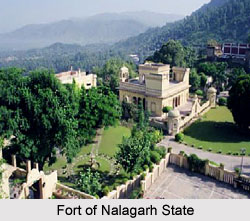 The Princely State of Nalagarh, also known as Hindur and Nawalgarh, was one of the native states of India during the rule of the British Empire in India. During the 19th century, the territory was appointed as one of the princely states of India under the indirect rule of the British Government. The state covered a total area of 256 sq miles and consisted of a total population of 52,737 in the year 1941. Nalagarh state was one of the 18 Shimla Hill States. The territory included around 675 villages and 1 town and was one of the westernmost States of the Shimla Hill States. The former state was bounded by the princely state of Bilaspur in the north; by the princely state of Baghal in the northeast; and by the princely state of Mahlog in the southeast; by the princely state of Patiala in the south; and by British territory of the Ambala Division of the Province of Punjab in the west and southwest. There were2 villages which were situated in a small enclave of Nalagarh state and were entirely enclosed within the boundaries of Mahlog.
The Princely State of Nalagarh, also known as Hindur and Nawalgarh, was one of the native states of India during the rule of the British Empire in India. During the 19th century, the territory was appointed as one of the princely states of India under the indirect rule of the British Government. The state covered a total area of 256 sq miles and consisted of a total population of 52,737 in the year 1941. Nalagarh state was one of the 18 Shimla Hill States. The territory included around 675 villages and 1 town and was one of the westernmost States of the Shimla Hill States. The former state was bounded by the princely state of Bilaspur in the north; by the princely state of Baghal in the northeast; and by the princely state of Mahlog in the southeast; by the princely state of Patiala in the south; and by British territory of the Ambala Division of the Province of Punjab in the west and southwest. There were2 villages which were situated in a small enclave of Nalagarh state and were entirely enclosed within the boundaries of Mahlog.
The Princely State of Nalagarh was incorporated as a part of Punjab States Agency, which was a political office of the British Government of India that managed a collection of princely states of India. The earlier name of the state Hindur was derived from the name of Handu, who was a Brahmin. He was a Brahmin who established his authority over the local rulers and formed his capital at Hindur.
History of Princely State of Nalagarh
The Chandel Rajputs of the Chandravanshi dynasty, who descended from the earliest Rajas of Chanderi in Bundelkhand, were the ruling family of Nalagarh state. Many other Rajputs occupied the region including Bais, Tomara, Panwar, Rathore, Pawar, Parmar and Chauhan. After Raja Ajit Chand ascended the throne of Bilaspur, his brother named Ajay Chand traveled to Hindur and assassinated the Brahmin Thakur. Thus Ajay Chand became the native ruler of the territory around 1110. During the 15th century, the capital was shifted to Nalagarh from Hindur. The region was later enlarged through several territorial occupations and was seized by the Gurkhas in the year 1803. The state was reassigned by the British East India Company in the year 1815 and the Raja of Nalagarh waived sovereignty over the regions that were seized before the invasion of the Gurkhas.
The Princely State of Nalagarh was ranked 11th among the Punjab Hill States, until the abolition of the separate agency in 1936 and its inclusion in the Punjab States Agency. The native ruler of Nalagarh, who held the title of Raja, state possessed full jurisdictionary authority and was compelled to pay implied compliance to any remonstrance or advice which the Resident of British India offered at different occasions. The entire princely state consisted of only one tahsil. Even though the former parganas sustained, but did not contain any administrative significance.
Nalagarh state was one of the original constituent members of the Chamber of Princes, a number of smaller states indirectly represented by 12 princes who were elected periodically by them. According to the Attachment Scheme of 1943, the princely states of Beja, Mangal, Kunihar, Kuthar, Dhami, Mahlog, Baghat and Baghal were attached to the princely states of Nalagarh, under the plan proposed by the Resident of British India for the Punjab States on April 17, 1944. It was done as the state was considered as capable of establishing the centre with which the other small native states, which did not have any survival value, could be merged.
In the year 1947, the former native state of Nalagarh was acceded to the newly formed Union of India, also known as Dominion of India, after the nation gained independence from the British administration and the partition of India. At present, the territory is a municipal committee and a city in the district of Solan, in Himachal Pradesh state, India.



















